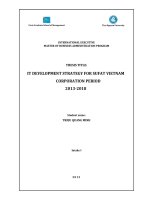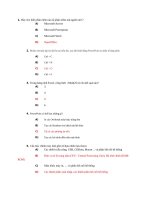Cs224W 2018 4
Bạn đang xem bản rút gọn của tài liệu. Xem và tải ngay bản đầy đủ của tài liệu tại đây (3.73 MB, 9 trang )
Link Prediction in Foursquare
Social Network
Francisco Izaguirre
Thawsitt Naing
Stanford University
1
Introduction
Link prediction is a classic problem in networks of great practical relevance — it can suggest to users who
they should follow in a social network, which song they might like based on their listening history, etc. Our
proposed project is to perform link prediction on Foursquare Social Network, which is a bipartite network
between users and venues they checked in at.
The diversity of the data set makes this a very interesting network to analyze. Given the current state of
the Foursquare social network, how accurately can we predict future edges between users and venues? Real
work networks can be vast and dynamic. Waiting for computation times to compute over days may simply
not be an option. With that in mind, how well can we predict missing links when we sample from our large
graph? What is the accuracy, precision, and recall based on the network partitions sampled? These are the
questions we aim to answer at the end of our research project.
2
Relevant
Prior Work
Liben-Nowell et al. formalized link prediction problem in their paper and performed link prediction on academic co-authorship network [1]. They used a number of similarity metrics such as graph distance, common
neighbors, Jaccards Coefficient, Adamic/Adar (Frequency-Weighted Common Neighbors), Preferential At-
tachment, Katz (Exponentially Damped Path Counts), and rooted PageRank. These methods constitute the
foundation of link prediction algorithms and provide a solid starting point for our project.
Boyao Zhu et al. explored the potential of the link prediction in weighted networks [2], which is directly
relevant to our project. They proposed Weighted Mutual Information (WMI) model which combines both
structural features and link weights to offer improved feature calculations for Weighted Common Neighbor
(WCN),
Weighted Adamic-Adar
(WAA),
and Weighted Resource Allocation (WRA).
These methods are
essentially the same as those used by Liben-Nowell et al., but they consider edge weights as an additional
input in the calculation of similarity scores.
3
Methodology
3.1
Data
Collection
Process
Our dataset is made up of five files.
— users.dat:
consists of a set of users such that each user has a unique
(latitude and longitude) that represents the user home town location.
— venues.dat:
consists of a set of venues
id and
a geospatial
location
(e.g., restaurants) such that each venue has a unique id and a
geospatial location (latitude and longitude).
— checkins.dat: marks the checkins (visits) of users at venues. Each checkin has a unique id as well as
the user id and the venue id.
2
F. Izaguirre et al.
— socialgraph.dat: contains the social graph edges (connections) that exist between users. Each social
connection consists of two users (friends) represented by two unique ids ( first_user_id and second_user_id).
— ratings.dat:
consists of implicit ratings that quantifies how much a
user likes a specific venue.
The core of our link prediction algorithms focus on checkins.dat, which constructs a bipartite graph
between users and venues. Other files will be added later for edge weights and additional heterogeneous data.
We used a Python script to process the data source, yielding white-space delimited mappings between user
and venue nodes that can be imported as an undirected graph with SNAP.
We noticed that the graph is extremely sparse and the majority of the nodes skew towards low degrees.
In addition, most of the users nodes have a degree of 1 (i.e. only checked into one venue), and there are a lot
of islands disconnected from the rest of the graph. This is problematic because we cannot calculate graph
distance on these nodes. In addition, this will cause our link prediction algorithms to have an extremely low
accuracy since most of the links predicted will not exist in the first place (since 60% of users only checked into
one venue). In order to solve this problem, we sampled our data set using the following reduction methods:
1. Retrieve the largest weakly connected component, which includes approximately 85% of nodes.
2. Remove user and venue nodes that have a degree less than d, where d is the minimum degree for each
node.
3. Repeat step 2 until all nodes in the network have at least degree d.
Based on the minimum degree d, this reduced our network size down to the connected sample networks listed
in table 2.
| Minimum
2
3
4
5
6
7
8
9
Degree
|# of nodes
|# of edges
|# of users
|# of venues
203590
91654
42779
19576
8094
3156
613
259
548331
334981
193949
104805
49892
21574
4909
2154
177521
79670
36650
16477
6678
2537
525
205
26069
11984
6129
3099
1416
619
88
54
Table 1: Network sample size per Minimum
3.2
Problem
|
Degree
Definition
Given a social network G = (V, E) in which each edge e = (u,v) € E represents an interaction between a
user node u and a venue node v, we want to accurately predict future edges based on the current state of
the network. First, the network is divided into training and testing sub-graphs.
All link prediction methods in this paper are score-based: all pairs of node (u,v) are assigned a score(z, y)
based on input graph G. Then, the scores are sorted in descending order such that pairs with higher scores
are more likely to be connected than those with lower scores.
We subtract the edges found in the training sub-graph from the ranked list of pairs. This results in predicted
new links, in decreasing order of confidence. We take the top n pairs and evaluate the performance based on
how many of those pairs appear as edges in the test sub-graph.
Link Prediction in Foursquare Social Network
Fig. 1: Graph Representation of Checkins Network
Fig. 2: Network edges split into training set (left, blue edges) and test set (right, orange edges)
4
F. Izaguirre et al.
3.3
Algorithm
After sampling nodes from the data-set, we need to split the data-set into train and test sets. However,
can’t split it by nodes because train and test sets need to contain the same nodes. Therefore, we split it
edges. Given a sampled data-set, we remove random edges from the graph until we have removed 20%
the edges. We store the removed edges as a test set. Therefore, we now have a training set with 80% of
original edges and a test set with 20% of the edges.
we
by
of
the
Then, we compute the similarity score of all possible (user, venue) pairs. Next, we choose the top 20%
with the highest scores and see how many of them appear in the test set. The metrics we used are listed in
detail below.
3.3.1
Distance: In this metric, we define score(, y) to be negative of the shortest path distance from x to
y because we want the shorter paths to have higher scores. In order to compute the shortest path efficiently,
we exploit the small-world property of the social network and apply expanded ring search.
Specifically, we initialize S = {x} and D = {y}. In each step, we either expand set S to include its members
neighbors (ie., S = SU {v|(u,v) € EMu € S}) or expand set D to include its members neighbors (i.e.,
D= DU {vl(u,v) € ENu € D}). We stop whenever SM D ! = @. The number of steps taken so far gives
the shortest path distance. For efficiency, we always expand the smaller set between S and D
in each step.
3.3.2.
Common Neighbors: The common-neighbors predictor captures the notion that two strangers
who have a common friend may be introduced by that friend. In a unipartite network, it is usually computed
as
Score(z,y) = |['(x) NI'(y)|
However, since our network is bipartite, we adapt this to
Score(z, )"Š°" = max(|T(+)nT+;)|) — forallz;e€
T0)
Score(z, )Y°""* = max(|T'()f1)|)
?(+)
— for alự¿c€
where Ï'(+) = the neighbors of user x and 7'{) = the neighbors of venue y. Therefore, we end up with two
metrics: common neighbors of users and common neighbors of venues.
3.3.3
Adamic/Adar (Frequency-Weighted Common Neighbors): Adamic/Adar refines the simple
counting of common features by weighting rarer features more heavily. For example, two users who have both
visited a less-known venue are probably more similar than those who have both visited a popular tourist
attraction. It is usually computed as
Score(z,) =
»
1
alr)
where |I"(z)| is the degree of z.
z€T(z)nT(w)
However, since our network is bipartite, we adapt this to
Score(4, 4) "8°? = 2 mre
ical
Score(,
4) "96 =
` inal
z€
4
1
log|F(2)|
where A = max(|I'(x) NI'(a;)|)
where B = max(|I'(y) A I'(y:)|)
for all x; € '(y)
for all
¿ € T (+)
Link Prediction in Foursquare Social Network
5
3.3.4
Preferential Attachment: Preferential Attachment implies that users with many friends tend to
create more connections in the future. In our context, we predict that a more outgoing user (i.e. a user node
with a high degree) is more likely to visit a venue which is more popular (i.e. a venue node with a high
degree). In this metric, we calculate the score as the product of the degrees of both nodes.
Score(z,0) = |Ƒ)| - |J'w)|
3.3.5
Katz (Exponentially Damped Path Counts): The Katz-measure is a variant of the shortestpath measure. The idea behind the Katz-measure is that the more paths there are between two vertices and
the shorter these paths are, the stronger the connection. It is defined as
5
Score(z,y) = Sos!
I=1
: IPath¿ „|
where Ø = a constant that is exponentially damped by length
|Path; „| = the number of possible paths of length | between x and y.
We choose 6 = 0.05 and compute |Path/ „| by doing a breath first search from node x. We stop at 1 = 5
because paths of length 3 or more contribute very little to the overall score. It’s worth noting that the path
length from a user to a venue is always an odd number since the graph is bipartite.
4
Results
We run our algorithm on three different sizes of sampled data set. For each sample, we calculate the precision
and recall of each of the predictors. As discussed in the paper by Liben-Nowell et. al. [1], many edges fail
to form for reasons outside the scope of the network. Therefore, the raw performance of our predictors is
relatively low. To more meaningfully represent predictor quality, we compare the results against a random
predictor baseline which simply randomly selects (user, venue) pairs that do not occur in the training network.
The results are shown in Table 2 below. A bold entry represents the highest performance.
Similarity Metric
Random Predictor
Distance
Common Neighbors (user)
Common Neighbors (venue)
Adamic/Adar (user)
Adamic/Adar (venue)
Preferential Attachment
Katz (G=0.005)
d > 6 (3156 nodes)
d > 7 (613 nodes)
d > 8 (259 nodes)
Accuracy | Precision] Recall | Accuracy | Precision] Recall | Accuracy | Precision] Recall
1.00
0.27% | 19.84%
1.00
2.19% | 20.59%
1.00
3.52% | 18.14%
1.27
0.35%
3.34
0.91%
2.90
3.24
3.23
3.27
2.89
0.79%
0.80%
0.88%
0.89%
0.80%
| 25.27%
0.72
|66.25%
1.73
|
|
|
|
|
57.44%
64.30%
64.14%
64.84%
57.30%
0.98
2.02
0.99
2.04
1.91
1.44%
| 14.78%
0.27
3.58% | 35.68%
0.55
2.08%
4.57%
2.15%
4.47%
4.19%
| 20.18%
| 41.59%
| 20.29%
|42.10%|
| 39.25%
0.36
1.15
0.41
1.12
1.24
0.95% |
4.88%
1.26% | 6.51%
4.07% | 20.93%
1.45% | 7.44%
3.93%
|20.23%
4.38%
|22.56%
1.94%
| 10.00%
Table 2: Results: Relative accuracy, precision, and recall for each dataset sample of minimum node degree d
As seen in Table 2, in the smallest sample of 259 nodes, the relative accuracy of some predictors is even
lower than the baseline. This shows that there is not enough information in the network to predict the
missing links. As the sample size increase, the relative performance of the predictors begin to improve. In
the 3156-node network, all predictor metrics outperform the random baseline by a factor of 2.8 on average.
We expect this trend to continue in larger sampled networks.
The precision values of our predictors are very low. We tried to make it better by taking a smaller percentage of the top scores as our predictions. However, in that case, both precision and recall drops closer to
F. Izaguirre et al.
Katz (beta=0.005)}
Preferential Attachment }
Adamic/Adar (venue) +
Adamic/Adar (user)
Neighbors (venue) +
Common
Common
Neighbors (user)
Random predictor |
Distance L
Đ
°
Relative performance ratio vs random predictions
°
JS
N
tu
te
Lo
w
wu
ơ
°
°
œ
°
œ
T
T
T
T
T
=
°
6
Fig. 3: Relative performance of each metric in 3156-node network (d > 6)
0%. This is the result of a sparse input network. Nonetheless, we expect better recall values as the sample
size increases. For example, in 3156-node graph, we are able to predict 66.35% of missing edges with the
Katz matrix.
In addition, we can see how different similarity metrics perform relative to each other even in a sparse net-
work. We found Common Neighbors (venues), Adamic/Adar (venue) and Katz to have consistently higher
performance. Another interesting thing we found
common neighbor metric.
5
is that
Adamic/Adar
performance
mirrors that
of the
Conclusion
In this paper, we outline a variety of methods to extract proximity-based features and path-base features
in order to calculate node scores and predict ”missing” edges between our training set and testing set. We
investigate the accuracy relative to a coin-flip, precision, and recall for varying network samples where each
node has at least degree d. The recorded metrics were considerably low in precision, but drastically improved
in recall as the d decreased and the network consisted of more nodes.
Real work networks can be vastly large. Feature extraction has proven to have very high runtimes, to
the point that by the time a similarity metric is calculated for each node, the dynamic nature of real work
networks could make the scores irrelevant. We demonstrate the relative accuracy, precision, and recall of
predicting missing links where we sample a large network and calculate similarity scores under 2 hours.
6
Future
Steps
Computation time was a growing concern for us. Though drastically reduced the size of our checkins dataset
after filtering out nodes that were not connected to the largest weakly connected component and had less
than the minimum degree threshold d, we encountered exceedingly long runtimes for computing similarity
Link Prediction in Foursquare Social Network
7
scores on dataset partitions where d < 6, consisting of more than 8000 nodes. These computations took more
than 48 hours to execute and sometimes would hit memory heap limitations, causing our laptops to force
restart and discard the running process.
It would be interesting to run these metrics for network samples where d < 6. To do so, consider the
following techniques to remedy the computational bottleneck:
— Multi-threading. A divide-and-conquer approach to allow a single virtual process dedicate itself to calculate similarity scores on a fixed range of user IDs.
— Utilizing dedicated computer clusters. Offloading the work to one of Stanfords machine clusters would
remarkably boost our computational resources and help execute processes faster. Alternatively, could
also dedicate GPU cores for running calculations, but like we mentioned above, the heap limitation is
also of concern.
— Implementing approximation methods. After researching some potential approximation techniques for
our metrics of concern, we have been considering running with more of these ideas. However, there are
several contingencies required for a network to approximate these metrics accordingly. These restraints
include network size, clustering coefficient, degree distribution, etc.
We believe that running these calculation on a larger portion of the network would yield higher accuracy
and a clearer trend on which scores work best for for missing edge detection.
References
1.
Liben-Nowell, David, and Jon Kleinberg.
of the Twelfth International Conference
doi:10.1145 /956958.956972.
‘The Link Prediction Problem for Social Networks.‘ Proceedings
on Information and Knowledge Management - CIKM 03, 2003.
2.
Zhu, Boyao, and Yongxiang Xia. ‘Link Prediction in Weighted Networks: A Weighted Mutual Information Model.‘
3.
WSong, Han Hee, et al. ‘Scalable Proximity Estimation and Link Prediction
Proceedings of the 9th ACM SIGCOMM Conference on Internet Measurement
doi:10.1145/1644893.1644932.
4.
H. Chen, X. Li and Z. Huang, ”Link prediction approach to collaborative filtering,” Proceedings of the
5th ACM/IEEE-CS Joint Conference on Digital Libraries (JCDL ’05), Denver, CO, 2005, pp. 141-142. doi:
10.1145 /1065385.1065415
5.
N. Benchettara, R. Kanawati and C. Rouveirol, ”Supervised Machine Learning Applied to Link Prediction in
Bipartite Social Networks,” 2010 International Conference on Advances in Social Networks Analysis and Mining,
Odense, 2010, pp. 326-330. doi: 10.1109/ASONAM.2010.87
6.
Holme, P., Liljeros, F., Edling, C.R., Kim, B.J.: On network bipartivity. Phys. Rev. E 68, 66536673
7.
O. Allali, C. Magnien and M. Latapy, ”Link prediction in bipartite graphs using internal links and weighted
projection,” 2011 IEEE Conference on Computer Communications Workshops (INFOCOM WKSHPS), Shanghai,
2011, pp. 936-941. doi: 10.1109/INFCOMW.2011.5928947
8.
Wang, Liang, et al. Robustness of Link-Prediction Algorithm Based on Similarity and Application to Biological
Networks. Current Bioinformatics, vol. 9, no. 3, 2014, pp. 246252., doi:10.2174/1574893609666140516005740.
9.
Newman,
10.
Dong, Yuxiao, et al. “Link Prediction and Recommendation across Heterogeneous Social Networks.“ 2012 IEEE
12th International Conference on Data Mining, 2012, doi:10.1109/icdm.2012.140.
Plos One 11, no. 2 (May 2016). doi:10.1371/journal.pone.0148265.
in Online Social Networks.‘
Conference - IMC 09, 2009,
(2003)
M. E. J. Clustering and Preferential Attachment in Growing Networks. Physical Review E, vol. 64, no.
2, 2001, doi:10.1103/physreve.64.025102.
F. Izaguirre et al.
Appendix
Degree Distribution of Foursquare Checkins Network
oO
wu
ơ
ow
â
ơ
Oo
ơ
So
&
â
ơ
Proportion of Nodes with a Given Degree (log)
B
oO
”
10°
10°
r
109
101
L
10?
L
Node Degree (log)
L
10°
10*
10°
Fig. 4: Degree distribution of Foursquare Checkins Network
0
40
Degree Distribution of USER NODES in Foursquare Checkins Network
109
Degree
Distribution of VENUE
NODES
in Foursquare
Checkins
Network
60% of users checked into only 1 venue
49.1% of venues have only 1 user who checked in
101
3
= 107
9
Š
Fact
8
=
Ẹ
10
s
a
ề
Š 102
5
ỗ
§ 10°
§
5
3
S
3
s§ 10°
:
c
2
10
ì
ane
s
§
§
5
Ễ
2
2
Bigs
10°
105
10°
101
Degree: number of venues checked in (log)
(a) Degree distribution of user nodes
102
105
109
101
102
102
Degree: number of users who checked in (log)
10%
(b) Degree distribution of venue nodes
Link Prediction in Foursquare Social Network
2
m
L
°
A
1
|
wn
a
1
aouejsiq
Z1
(1asn) s1oquBIaN uouiuIo2
(anuaA) sioquBIaN uou1uio2
(1asn) Iepy/2IuIepy
(anuaA) 1epy/2IuIepy
1u9U1U2E13V |EI}u912J21d
| (S00'0=812q)
E
So
3
=
o
ỹ
"ĐSs
a=)
5
2Đ
1
°
So
4
i
ba
So
a
°
=
°
N
a
ta
L
°
a
Random predictor
L
L
tO
6
Su0I12Ipa1d u1Iopue1 SA 0I1e1 22ueUI10112d 2AI1E|2y|
|EI13u919J91d
(S00'0=819q) Z3
3u9U1u5E1y
(anuaA) 1epy/2IuIiepy
(1asn) 1epy/2Iuuepy
(anuaA) sioquBIaN uouIuio2
(1asn) s1oquBIaN uouiuio2
92uE1SIq
0.0
|
L
HỆ
ä
Su0I12Ipa1d uI0pUE1 SA 0I1E1 2UEUI10119d ðAI1E|9y|
Fig. 5: Relative performance of each metric in 613-node network (d > 7)
Eig.6: Relative performance of each metric in 259-node network (d > 8)









